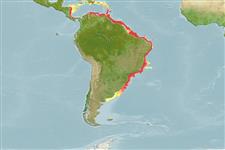Common names from other countries
>
Eupercaria/misc (Various families in series Eupercaria) >
Sciaenidae (Drums or croakers)
Etymology: Cynoscion: Greek, kyon = dog + Greek, odous = teeth + Greek, skion, skiaina = barbel, red mullet (Ref. 45335).
More on authors: Vaillant & Bocourt.
Environment: milieu / climate zone / depth range / distribution range
ນິເວດວິທະຍາ
ສັດທະເລ; ນ້ຳກ່ອຍ ອາໄສຢູ່ໃກ້ໜ້າດິນໃຕ້ພື້ນທ້ອງນ້ຳ; ລະດັບຄວາມເລິກ 1 - 70 m (Ref. 9626), usually 18 - 55 m (Ref. 9626). Subtropical; 18°N - 52°S, 83°W - 34°W
Western Atlantic: Panama and the Greater Antilles to Argentina. Including Lesser Antilles (Ref. 26938). Also reported in Nicaragua (Ref. 13613).
Length at first maturity / ຂະໜາດ / ນ້ຳໜັກ / Age
Maturity: Lm 25.1, range 15 - ? cm
Max length : 56.9 cm TL ຕົວຜູ້/ບໍ່ມີເພດ; (Ref. 125970); common length : 35.0 cm TL ຕົວຜູ້/ບໍ່ມີເພດ; (Ref. 3702); ນ້ຳໜັກສູງສຸດທີ່ເຄຍຈັດພີມມາ: 2.2 kg (Ref. 125970)
ຄີ (ໜາມ)ແຂງຢູ່ຫຼັງປາ (ທັງໝົດ) : 11; ຄີຫຼັງຂອງປາ (ຄີອ່ອນ) (ທັງໝົດ) : 23 - 27; ຄີ(ໜາມ) ແຂງຢູ່ຄີກົ້ນປາ
ກຸ່ມປາກະດູກແຂງ
ຄວາມຖີ່ຂອງກຸ່ມຖ່າຍທອດພັນ
ປາທີ່ມີການເຄື່ອນຍ້າຍຈາກທະເລໄປຫານ້ຳຈືດ ແລະນ້ຳຈືດຫາທະເລ
ປາທີ່ມີການເຄື່ອນຍ້າຍຈາກທະເລແລະໄປໄຂ່ຢູ່ນ້ຳຈືດ
ຄີກົ້ນຂອງປາ
ສັດທີ່ມີກະດູກສັນຫັຼງ
ການຖ່າຍທອດທາງກຳມະພັນຈາກພໍ່ແມ່ຫາລູກ: 2; ຄີກົ້ນຂອງປາ: 9. Colour greyish above, silvery below. Without conspicuous spots, but with faint dark streaks along scale rows above lateral line. Pectoral-fin bases and upper rays slightly dark, pelvic and anal fins often yellowish, dorsal and caudal fins dusky with darker margin. Inside opercle darkish visible externally. Mouth large, oblique, lower jaw slightly projecting. Upper jaw with a pair of large canine-like teeth at tip. Chin without barbel or pores, snout with only 2 marginal pores. Gas bladder with a pair of horn-like anterior appendages. Sagitta (large earstone) moderately broad and thick, Lapillus (small earstone rudimentary. Scales large. Soft portion of dorsal-fin base covered with small scales up to 1/2 of fin height (Ref 51721).
Found over sand or mud bottoms from the coastline to about 60 m depth (Ref. 3702); rarely in waters with a depth of less than 18 m (Ref. 9626). Juveniles inhabit river estuaries (Ref. 3702). Oviparous, with high fecundity (Ref. 54358). Feed on fishes and crustaceans like crabs and shrimps (Ref. 35237). Important food fish (Ref. 3702).
Cervigón, F., 1993. Los peces marinos de Venezuela. Volume 2. Fundación Científica Los Roques, Caracas,Venezuela. 497 p. (Ref. 9626)
IUCN Red List Status (Ref. 130435)
Can't connect to MySQL database (fbapp). Errorcode: Too many connections
